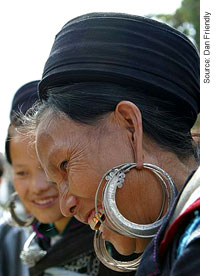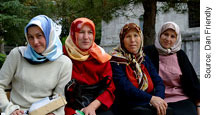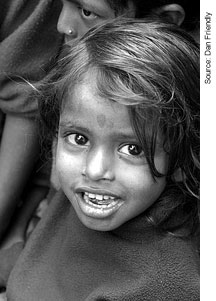International Day for the Elimination of Violence Against Women - 11/25/04
 |
| Festively dressed women in Asia. |
Supporters for the elimination of violent behavior against women have marked November 25 as a day of commemoration since 1981, the same day as the brutal 1961 assassination of the three Mirabal sisters. Dominican leader Rafael Trujillo (1930-1961) assassinated Patria Mercedes Mirabal-Reyes, Minerva Argentina Mirabal-Reyes, and Maria Teresa Mirabal, political activists in the Dominican Republic, for their work against his dictatorship. On December 17, 1999, the United Nations General Assembly declared November 25 as the International Day for the Elimination of Violence Against Women. USAIDís Office of Population and Reproductive Health is one of many organizations proud to celebrate this cause.
Gender-Based Violence Prevalence World-Wide
Around the world, at least one out of three women are beaten, coerced into sex or otherwise abused during their lifetime. Women are most at risk at home and from men they know, usually a family member or spouse. Data from USAID-funded MEASURE DHS shows that domestic violence directly impacts the health and well-being of abused women. Profiling Domestic Violence: A Multi-Country Study [PDF, 4MB], is a comprehensive analysis of domestic violence in nine developing countries based on data from Demographic and Health Surveys (DHS). Overall, the report finds high rates of domestic violence in all cases and specifies that over 40% of women in several countries report being victims of spousal or intimate partner abuse.
In summary, the number of ever-married women reporting spousal physical or sexual abuse was highest in Zambia (48%), Colombia (44%), and Peru (42%) and lowest in Cambodia (18%), India (19%), and the Dominican Republic (22%). About one in three women in Egypt (34%), Nicaragua (30%) and Haiti (29%) reported such abuse. Interestingly, in most countries, the highest rates of violence occur in moderately wealthy households and not, as commonly assumed, among the poorest households.
The DHS report also shows that children of abused women are more likely to suffer health problems. In addition, the report illustrates that infant and mortality rates are higher among women who have been victims of violence when compared to women who have not experienced any form of violence. For instance, in Cambodia, Egypt, India, Nicaragua, and Zambia, infant and child mortality rates were higher for abused women. View the full report here [PDF, 4MB].
USAIDís Interagency Gender Working Group
USAIDís Interagency Gender Working Group (IGWG) is a network comprising of USAID and its implementing partners, as well as nongovernmental organizations. The IGWG works to promote gender equity within population, health, and nutrition programs, with the goal of improving reproductive health/HIV/AIDS outcomes and fostering sustainable development. The IGWG serves as the focal point on gender integration in reproductive health/HIV/AIDS programs. It is engaged in gender equity education, advocacy, development of operational tools, and collection and dissemination of best practices. In particular, IGWG activities focus on gender-based violence (www.igwg.org/priorityareas/violence.htm) , youth and gender, gender implications and vulnerabilities of HIV/AIDS, and male involvement and dual protection.
 |
| Turkish women outside of the Blue Mosque in Istanbul. |
Related Publications and Resources
 |
| A young Nepalese girl. |
USAID and Female Genital Cutting
|


